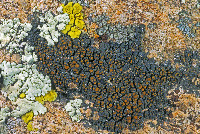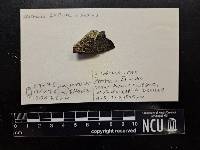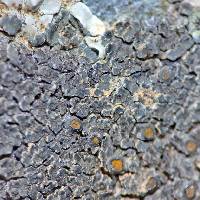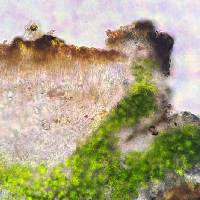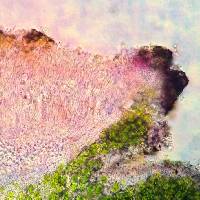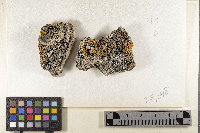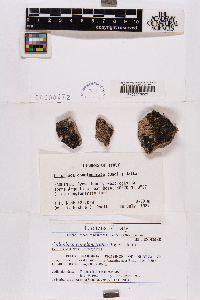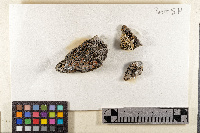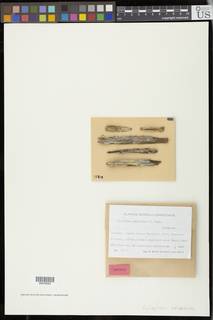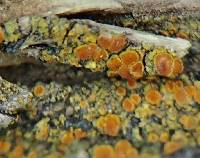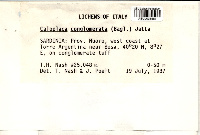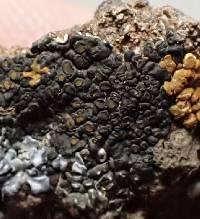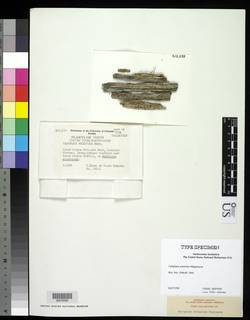
Consortium of Lichen Herbaria
- building a Global Consortium of Bryophytes and Lichens as keystones of cryptobiotic communities -
- Home
- Search
- Images
- Species Checklists
- US States: O-Z >
- US National Parks
- Central America
- South America
- US National Parks
- Southern Subpolar Region
|
|
|
|
Family: Teloschistaceae
[Callopisma conglomeratum Bagl., moreCaloplaca amabilis Zahlbr., Caloplaca arizonica E.D. Rudolph (non H. Magn.) nom. illegit., Caloplaca conglomerata (Bagl.) Jatta, Caloplaca conglomerata var. conglomerata (Bagl.) Jatta, Caloplaca pelodella (Nyl.) Hasse, Caloplaca peregrina Samp., Caloplaca plumbeo-olivacea H. Magn., Caloplaca sideritis var. elaeodes E.D. Rudolph, Lecanora pellodella Nyl., Pyrenodesmia elaeodes E.D. Rudolph, Pyrenodesmia pellodella (Nyl.) E. Rud. nom inval.] |
Nash, T.H., Ryan, B.D., Gries, C., Bungartz, F., (eds.) 2007. Lichen Flora of the Greater Sonoran Desert Region. Vol 3. Life habit: lichenized Thallus: squamulose, subsquamulose, without elongated lobes; prothallus: absent surface: olive-gray, smooth, without asexual propagules cortex: cellular, 28-77 µm thick, granules absent; medulla without granules Apothecia: adnate, 0.2-1 mm in diam., lecanorine disc: orange, flat, epruinose margin: persistent, slightly raised; thalline margin present, concolorous with thallus; proper margin not visible parathecium: elongate to oval cells; exciple below hypothecium irregular hyphae epihymenium: golden, K+ red, H-, 10%N-, cN-, C- hymenium: hyaline, 55-70 µm tall paraphyses: 2-3 tip cells slightly swollen, with some branching; subhymenium hyaline asci: cylindrical, 8-spored ascospores: hyaline, 2 locules, ellipsoid, 11-14 x 5.5-7 µm, isthmus 3-4 µm, spore end wall thin Pycnidia: present, totally immersed Spot tests: apothecial margin K+ violet, H+ violet, 10% N+ violet, cN+ violet, C+ violet; thallus K+ violet, H+ violet, 10%N+ violet, cN+ violet, C+ violet Secondary metabolites: unidentified anthraquinones and thalloidima green. Substrate and ecology: on non-calcareous rocks or occasionally on calcareous rocks World distribution: western North America Sonoran distribution: Arizona, southern California, Baja California, Baja California Sur, and Sonora. Notes: Caloplaca pellodella in its typical form is a very distinctive species with its orange apothecia and dark greenish gray squamulose thallus. The thallus margin is usually distinctly squamulose with slightly lobed, convex squamules. Some collections have a poorly developed thallus and might be mistaken for C. sideritis but that species is usually areolate at the thallus margins, has a lighter gray thallus, has fewer elongated thick walled cells in the proper exciple. In addition, C. pellodella has a thick, smooth necral layer on the thallus and a thicker cellular cortex below the colored layer. The shiny appearance of the thallus is due to the smooth necral layer. Caloplaca hueana has a strictly brown thallus and lacks the necral layer on the thallus cortex and the thallus is completely K-. |
|
|
|
Powered by Symbiota








